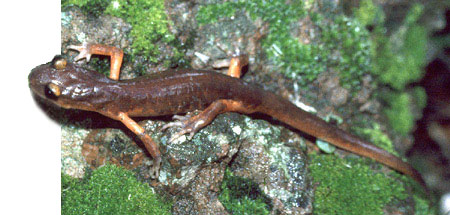

|
Ensatina (Ensatina eschscholtzi) What they look like: Ensatina is a species of salamander that displays a variety of colors from reddish to brown to black. They are often yellow to orange at the base of legs. The Ensatina is a lungless amphibian that breathes through its smooth moist thin skin. They reach a total length of three to five inches, and can be identified primarily by the structure of the tail - it is narrower at the base. If its tail snaps off when it is trying to escape a predator, then the tail will grow back. Salamanders have four front toes and their hind legs have five. Their moist skin makes them reliant on habitats in or near water, or under some protection (e.g., moist ground), often in a wetland. They are unique among vertebrates, since they are capable of regrowing lost limbs, as well as other body parts.
Ensatina is most commonly associated with woody debris, downed logs, and bark piles at the base of snags and is sometimes in wood piles in peoples' yards west of the Cascades. Inhabits moist shaded forests and oak woodlands. Click the range map to learn more about the distribution of Ensatina in California. What they eat: Ensatina eats a wide variety of invertebrates. Behavior: Ensatina live in cool moist places on land. They stay underground during hot and dry periods where they are able to tolerate dehydration. They are the most active on rainy nights when temperatures are moderate. The detachable tail allows the Ensatina a quick escape. A constriction at the base of the tail causes its tail to fall off when it is grabbed by a predator. Reproduction: Ensatina breeds mainly in fall and spring, but may also breed throughout the winter. Females lay eggs on land at the end of the rainy season. The eggs are brooded under bark, in rotting logs or underground. Females lay from 3-25 eggs, but 9-16 eggs are the most common.
Did you know?

Monterey Salamander photo by Chris Brown More information: |
Animal silhouettes available to purchase »
Photos: WDFW, Chris Brown
Home | About Us | How to Participate | Biodiversity Modules | Projects | Maps | News | Resources